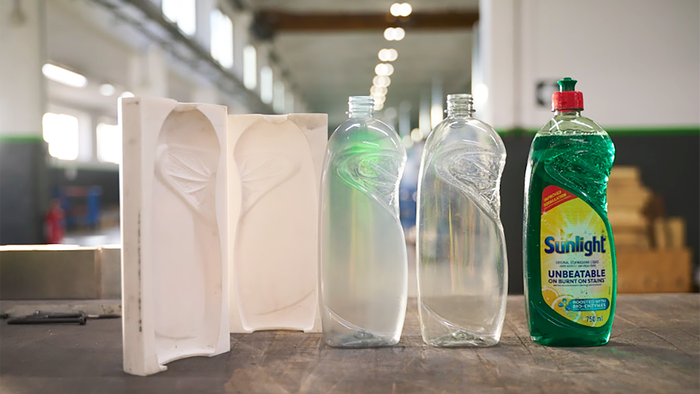Amazon’s Switch to Paper Cushioning Prioritizes Curbside Recycling, and Profits
Switching out plastic air-pillow cushioning for paper filler avoids the use of plastic delivery packaging from two billion packages annually — and improves the bottom line.

At a Glance
- Amazon's switch to paper filler will eliminate nearly 15 billion plastic air pillows annually.
- The paper filler is made from 100% recycled content and can be easily recycled through curbside collection programs.
- This change also improves packing efficiency and reduces costs, benefiting both Amazon and consumers.
Amazon’s switch in North America from plastic film air-pillow cushioning to paper filler saves the company time and money. And, yes, it’s better for the environment.
Amazon’s change of cushioning material is a lucky confluence of sustainability and profitability. And should be a lesson for other companies looking to improve the bottom line and please consumers at the same time.
On June 20, Amazon announced that 95% of its ecommerce cushioning for packages shipped in boxes in North America is now paper filler. The expectation is that the company will be at 100% by end of year.
To date, this will be Amazon’s largest plastic packaging reduction effort in North America and will eliminate nearly 15 billion plastic air pillows from about two billion shipments annually.
Amazon says this is another step in its multi-year journey to avoid and reduce packaging, specifically plastic packaging. The company tested the switch from plastic air pillows to paper filler at an automated fulfillment center in Ohio last fall. According to the company, lessons learned during that trial allowed Amazon to transition to paper filler for 95% of its shipments in North America in less than one year.
The benefits for Amazon, consumers, and the planet.
Amazon is replacing plastic air pillows with paper filler for several sustainability reasons:
• Consumers can easily recycle the paper filler through their curbside collection programs. This should translate into more shipping material being recycled.
• The equipment for feeding the paper cushioning at pack stations takes less space, making it easier for employees to pack the orders.
• The paper filler is made of 100% recycled content, post-consumer and post-industrial, creating a pull-through market for recycled fiber.
• Because the paper filler can absorb impacts better than the air pillows, Amazon is able to assure consumers their orders will arrive intact — and continue to avoid costly product damage.
But Amazon also realizes these business improvements:
• Packers can pack faster because the paper filler is easier to handle than the air pillows. It follows that facilities will be able to process more orders with the same staff.
• The equipment that feeds the paper filler costs less than what was used for the air pillows. However, Amazon was vague with answers to my questions about material and shipping costs (see answers below). I believe the equipment savings might offset the cost difference between the two materials, as well as the additional shipping costs of the heavier paper cushioning. Although, Amazon also said in a blog post that this change allows them to use “as little packaging as possible to avoid waste …” So maybe it is using less paper filler than air pillows.
• The paper filler cushions better because it conforms to the products in the order better than the air pillows. This should minimize product damage even more; and save on returns and unsellable product.
All that being said, this move is hailed as a win for circularity.
Amazon has gotten significant press on this move, including a look at how the new paper filler is working inside one of Amazon’s fulfillment facilities by CBS News.
Packaging Digest asked several questions itself, which a team of people at Amazon answered in this exclusive Q&A.
The paper filler that Amazon is now using is made of 100% recycled fiber that is both post-industrial and post-consumer. What is the percentage of post-consumer content? Is that certified?
Amazon: We are partnering with several packaging supply partners that use raw material from paper mills in North America made from 100% recycled content, from both post-industrial and post-consumer recycling for our paper filler. We don’t have the percentage breakdown to share.
How is Amazon communicating to consumers that this paper filler is recyclable? Is there a message printed on the material? A note in or on the box?
Amazon: One of the many places consumers can find information about what to do with their delivery packaging is through this link.
Amazon is using artificial intelligence (AI) to right-size its packages. Is AI also used to help packers identify the proper amount of paper filler for each order? Or are the packers making that decision themselves?
Amazon: Through our testing of paper filler—which included an assessment by a third-party engineer lab – we were able to determine the amounts needed. Amazon employees were then trained on this. You can also find more info here on how Amazon is using AI to reduce packaging: https://www.aboutamazon.com/news/sustainability/amazon-sustainability-ai-reduce-packaging
According to the Amazon blog, “Our teammates in our fulfillment centers love it.” One employee cited less space needed for the machinery for the paper cushioning, which makes it easier for him to do the order packing. Does “easier to pack” equate to “faster to pack”?
Amazon: Yes.
Can Amazon guarantee enough supply of the 100% recycled content to cushion 2 billion packages annually? Who are your suppliers? Are they manufacturing in North America?
Amazon: Yes, we’re working with several packaging supply partners throughout North America.
In North America, what other cushioning materials does Amazon use beyond the paper filler and phased-out air pillows? Or is all your cushioning now only paper filler?
Amazon: For our boxes, air pillows were the only material used as cushioning. 95% of those have been replaced and we’re working towards full removal by end of year. So it will only be paper filler.

AMAZON
Some of the air pillows I received as an Amazon customer were either recyclable for store drop-off or made of bioplastic. Both of those products have a sustainability message. Why is curbside recyclable paper packaging better?
Amazon: When it comes to packaging, our priority is to reduce the amount of packaging and make it easier to recycle. We’re always working backwards from our customer. Needing to take the plastic air pillows to a store drop-off isn’t an ideal customer experience. Paper filler allows our customers to more easily recycle their packaging at home.
What was required in making the switch from plastic air pillows to the paper cushioning? New equipment, obviously. Employee training or guidance, right? What else?
Amazon: A lot of work went into reaching this significant milestone. In addition to replacing the plastic air pillow machinery, fulfillment center employees had to be trained and we partnered with Stress Engineering Services (a third-party engineering design and analysis company) to evaluate the effectiveness of paper filler compared to plastic air pillows for protecting products and ensure the paper filler provided the same if not better protection than the plastic air pillows. Additionally, the teams strategically created an implementation schedule to ensure we would be utilizing our current supply of plastic for air pillows.
How does the paper cushioning compare by weight to plastic air pillows? If it’s heavier, how will that impact the company’s shipping fees and profits?
Amazon: Sustainability is good for business, it’s what our customers want and we’re always working backwards from the customer. We want to ensure the product gets to them undamaged — and from there we want to use less packaging and make it easier to recycle. Additionally, we do anticipate cost savings associated with the transition to paper filler as we’re finding the equipment has less fees associated.
Extensive testing was done with consumers, employees, and third-party experts. What were the test results on the protection value of the paper filler vs the air pillows?
Amazon: As a result of our testing with Stress Engineering Services, we’ve found the paper filler can absorb impact better than the air pillows.

Paper filler is supplied in rolls to Amazon's fulfillment centers. AMAZON
What is the cost difference between the two cushioning products?
Amazon: [As previously stated: Sustainability is good for business, it’s what our customers want and we’re always working backwards from the customer. We want to ensure the product gets to them undamaged — and from there we want to use less packaging and make it easier to recycle.]
Additionally, we do anticipate cost savings associated with the transition to paper filler as we’re finding the equipment has less fees associated.
In the future, if/when plastic films are also collected at curbside, do you still think the business case will be there to use paper packaging materials instead of plastic?
Amazon: We use a science-based approach that includes continuous materials and technology innovation to find solutions that are good for both customers and the planet. Today, replacing plastic air pillows with paper filler made out of 100% recycled content allows customers to more easily recycle our packaging at home.
We also teamed up with the US Department of Energy to cut plastic waste through the BOTTLE consortium [Bio-Optimized Technologies to keep Thermoplastics out of Landfills and the Environment], which focuses on reducing plastic pollution through innovation and recycling. As part of this consortium, Amazon’s team of materials scientists and experts hopes to develop technologies and materials that will enable the full life cycle of plastics to be net-zero carbon. You can find out more here.
About the Author(s)
You May Also Like




